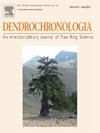东乌拉尔放射性痕量区桦树的径向生长受到影响:是电离辐射的影响,还是竞争、气候条件和噬菌体的影响?
IF 2.7
3区 农林科学
Q1 FORESTRY
引用次数: 0
摘要
树木年轮分析提供了几十年到几千年的环境条件的历史记录。本文研究了1957年Kyshtym核事故影响下的白桦树径向年生长与森林放射性污染水平的关系。在事故发生后的头二十年里,Kyshtym事故的辐射事件的总体影响似乎是不一致的(增长或下降)。考虑到涉及的变量众多,建立单一的因果关系是具有挑战性的。最初,辐照、干旱和海绵蛾(Lymantria dispar L.)爆发的组合显著降低了树的径向生长。到1960年,短寿命的放射性核苷酸已经明显衰变,导致在最受污染的地点的γ辐射暴露减少了100-1000倍,而辐射敏感的松树(Pinus sylvestris L.)在松桦林中死亡。从1960-1967年,白桦树在枯松和中度污染地区的径向生长最大,但在严重污染地区的径向生长较小,尽管在1973-1978年发生了严重干旱,但径向生长有所恢复。从1979年到2019年,东乌拉尔放射性痕迹(EURT)和对照点的桦树径向生长保持稳定。本文章由计算机程序翻译,如有差异,请以英文原文为准。
Impacted radial growth of birch in the East-Ural Radioactive Trace Zone: Effects of ionizing radiation or of competition, weather conditions, and phytophages?
Tree ring analysis offers a historical record of environmental conditions spanning decades to millennia. We studied the relationship between the annual radial growth of silver birch (Betula pendula Roth) and the radioactive contamination levels of forests impacted by the Kyshtym accident (1957), a major nuclear incident. The overall effect of the radiation event from the Kyshtym accident appears to be inconsistent (increased and decreased growth) for the first two decades following the incident. Given the multitude of variables involved, it is challenging to establish a singular causal relationship. Initially, the combination of irradiation, drought, and spongy moth (Lymantria dispar L.) outbreaks significantly reduced radial tree growth. By 1960, short-lived radionucleotides had decayed significantly, resulting in a 100–1000 fold decrease in γ radiation exposure at the most contaminated sites, while radiosensitive pine (Pinus sylvestris L.) died in mixed pine–birch forests. From 1960–1967, birch trees at sites with dead pines and moderate contamination experienced the greatest radial growth from reduced competition, but smaller radial growth at heavily contaminated sites, recovering in 1973–1978 despite a major drought. From 1979–2019, birch tree radial growth in the East-Ural Radioactive Trace (EURT) and control sites remained stable.
求助全文
通过发布文献求助,成功后即可免费获取论文全文。
去求助
来源期刊

Dendrochronologia
FORESTRY-GEOGRAPHY, PHYSICAL
CiteScore
5.50
自引率
13.30%
发文量
82
审稿时长
22.8 weeks
期刊介绍:
Dendrochronologia is a peer-reviewed international scholarly journal that presents high-quality research related to growth rings of woody plants, i.e., trees and shrubs, and the application of tree-ring studies.
The areas covered by the journal include, but are not limited to:
Archaeology
Botany
Climatology
Ecology
Forestry
Geology
Hydrology
Original research articles, reviews, communications, technical notes and personal notes are considered for publication.
 求助内容:
求助内容: 应助结果提醒方式:
应助结果提醒方式:


